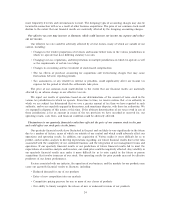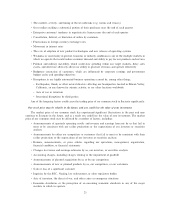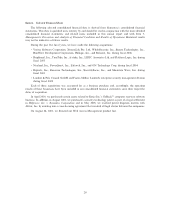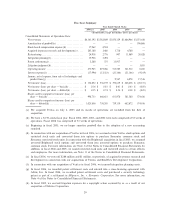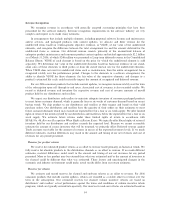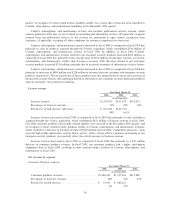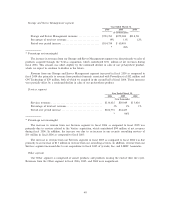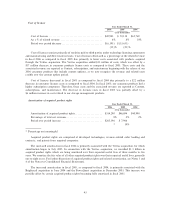Symantec 2006 Annual Report Download - page 40
Download and view the complete annual report
Please find page 40 of the 2006 Symantec annual report below. You can navigate through the pages in the report by either clicking on the pages listed below, or by using the keyword search tool below to find specific information within the annual report.Revenue Recognition
We recognize revenue in accordance with generally accepted accounting principles that have been
prescribed for the software industry. Revenue recognition requirements in the software industry are very
complex and require us to make many estimates.
In arrangements that include multiple elements, including perpetual software licenses and maintenance
and/or services, and packaged products with content updates, we allocate and defer revenue for the
undelivered items based on vendor-specific objective evidence, or VSOE, of fair value of the undelivered
elements, and recognize the difference between the total arrangement fee and the amount deferred for the
undelivered items as revenue. Our deferred revenue consists primarily of the unamortized balance of
enterprise product maintenance and consumer product content updates and totaled approximately $2.2 billion
as of March 31, 2006, of which $248 million was presented as Long-term deferred revenue in the Consolidated
Balance Sheets. VSOE of each element is based on the price for which the undelivered element is sold
separately. We determine fair value of the undelivered elements based on historical evidence of our stand-
alone sales of these elements to third parties or from the stated renewal rate for the undelivered elements.
When VSOE does not exist for undelivered items such as maintenance, then the entire arrangement fee is
recognized ratably over the performance period. Changes to the elements in a software arrangement, the
ability to identify VSOE for those elements, the fair value of the respective elements, and changes to a
product's estimated life cycle could materially impact the amount of recognized and deferred revenue.
For our 2006 consumer products that include content updates, we recognize revenue ratably over the term
of the subscription upon sell through to end users. Associated cost of revenues is also recorded ratably. We
record as deferred revenue and inventory the respective revenue and cost of revenue amounts of unsold
product held by our distributors and resellers.
We expect our distributors and resellers to maintain adequate inventory of consumer packaged products
to meet future customer demand, which is generally four or six weeks of customer demand based on recent
buying trends. We ship product to our distributors and resellers at their request and based on their valid
purchase orders. Our distributors and resellers base the quantity of their orders on their estimates to meet
future customer demand, which may exceed our expected level of a four or six week supply. We offer limited
rights of return if the inventory held by our distributors and resellers is below the expected level of a four or six
week supply. We estimate future returns under these limited rights of return in accordance with
SFAS, No. 48, Revenue Recognition When Right of Return Exists. We typically offer liberal rights of return if
inventory held by our distributors and resellers exceeds the expected level. Because we cannot reasonably
estimate the amount of excess inventory that will be returned, we primarily offset Deferred revenue against
Trade accounts receivable for the amount of revenue in excess of the expected inventory levels. If we made
different estimates, material differences may result in the amount and timing of our net revenues and cost of
revenues for any period presented.
Reserves for product returns
We reserve for estimated product returns as an offset to revenue based primarily on historical trends. We
fully reserve for obsolete products in the distribution channels as an offset to revenue. If we made different
estimates, material differences could result in the amount and timing of our net revenues for any period
presented. More or less product may be returned than what was estimated and/or the amount of inventory in
the channel could be different than what was estimated. These factors and unanticipated changes in the
economic and industry environment could make actual results differ from our return estimates.
Reserves for rebates
We estimate and record reserves for channel and end-user rebates as an offset to revenue. For 2006
consumer products that include content updates, rebates are recorded as a ratable offset to revenue over the
term of the subscription. Our estimated reserves for channel volume incentive rebates are based on
distributors' and resellers' actual performance against the terms and conditions of volume incentive rebate
programs, which are typically entered into quarterly. Our reserves for end-user rebates are estimated based on
34


